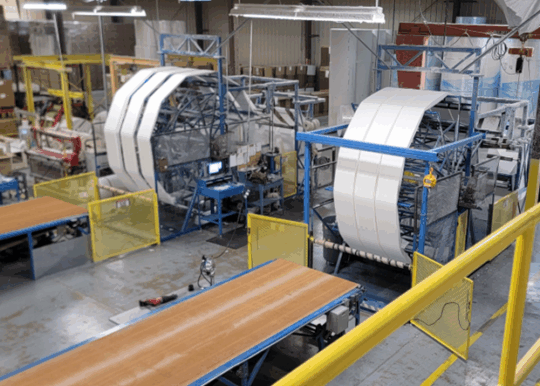Background:
Hindon serves as a supplier to a leading manufacturer of specialty linen products such as napkins, industrial wipers, bath towels, and continuous roll towels. Their midwestern U.S. plant produces large reels of the linen products and then uses a rewinder machine to convert these reels into smaller, neatly wound rolls that are ready to be packaged and delivered to their customers. The plant was interested in upgrading their rewinder machine’s safety features to meet modern standards. Specifically, the rewind wheel was using a pneumatic braking system that took too long to stop the machine and did not provide for fail-safe operation.

Linen products manufacturers use rewinder machines like the ones pictured above to convert their products to meet their customers’ needs.
The customer required a fast-acting brake to stop the wheel in 1-2 seconds, a requirement that initially had the customer looking at electromagnetic brakes. Additionally, the customer required the braking system to be capable of adjustable torque during operation (typically associated with actively applied brakes) while also functioning as a fail-safe brake in the event of emergency power loss or if a safety door was opened. Lastly, some of the braking requirements such as torque requirement were unclear due to the age of the existing equipment and the lack of a nameplate for the existing brake.

The customer’s existing brake disc and ineffective brake
Application Challenges:
- Initially undefined torque requirement
- Stopping time needed to be 2 seconds or less
- Requirement for dual operation – the brake needed to be actively applied (for operator controlled braking) while also fail-safe (for emergency use in the case of unsafe entry and/or loss of power)
Solution:
Because the customer already had an existing air supply and the required torque was within the range of pneumatic brakes, a pneumatic braking system provided the most practical and cost-effective solution. After reviewing the customer’s requirements and preferences in detail, Hindon was able to provide a brake specification that would stop the system in less than 2 seconds. This industrial brake needed to be engineered to surpass the customer’s stopping time requirements without knowing the system’s inertia, so Hindon determined the braking torque requirement from the motor specifications and rewind wheel RPM, applying appropriate safety factor. To exceed these requirements, while providing the end-user adjustability, Hindon supplied a dual function (pneumatically applied, spring released / spring applied, pneumatically released) disc brake caliper for use on the customer’s existing brake disc.

3D image of the dual function spring applied, pneumatically released disc brake provided by Hindon
The dual functionality of the chosen brake was key to meeting all the customer’s technical and budgetary requirements. The pneumatically applied, spring-released mode allowed for active, operator-controlled braking during normal operation, with precisely adjustable air pressure providing variable torque for the winding process. For safety, the spring-applied, pneumatically released mode automatically engaged in emergencies (power loss, emergency stop, or safety door open), providing fail-safe braking that stopped the rewind wheel within 1-2 seconds. By leveraging the customer’s existing air supply and existing brake disc, Hindon’s solution minimized modifications, simplified installation, and aided the cost effectiveness of the overall solution.